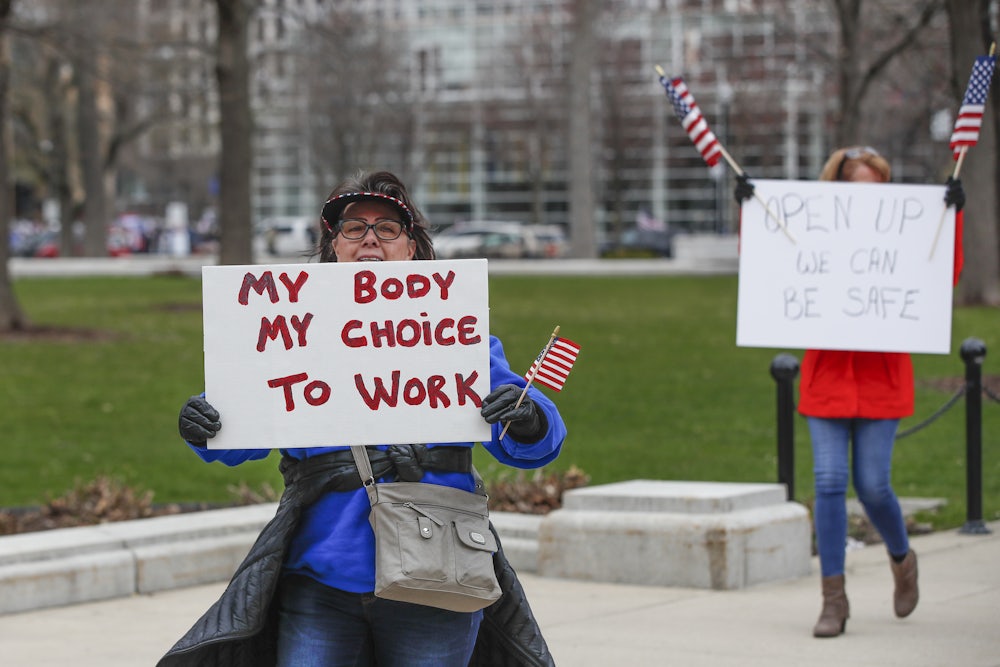Politico co-founder John F. Harris last week delivered a dire warning about the right-wing anti-lockdown protests that were then just beginning to spread across the country. “The wake of the coronavirus will be a powerful boost to the animating spirit of libertarianism: leave me alone,” he wrote. “Ideology hasn’t been suspended. It has been forcibly suppressed—in ways that inevitably will come roaring back, sometimes in highly toxic ways.”
In Michigan, a few thousand people protested outside the state’s capitol building. In other states—including Kentucky, Utah, and New York—the protests were significantly smaller. The coverage, however, was outsize, with mainstream media outlets heralding the arrival of a new Tea Party. Writing in The Guardian, Cas Mudde wrote that the protests have provided President Trump “with visible popular support for his Covid-19 strategy.” Fox News egged the protesters on. The New York Times, Politico, and The Washington Post identified shadowy conservative groups as the puppet-masters behind the rallies, pulling the strings of protesters for their own ends.
In the anti-lockdown protests, you had everything: the (not so) hidden hand of Fox News and right-wing influencers, the president’s political future, and the arrival of a seemingly frightening backlash to the quarantine regime. The visuals—masks, guns, nutty signs—made the protests irresistible.
But there is good reason to believe that these protests have been significantly overhyped—and that credulous media reporting has boosted the profile of right-wing organizations that have done very little of note. Far from a new Tea Party, this movement is tiny, disconnected, and not reflective of public opinion in any meaningful way.
The media coverage of the protests, both from right-wing and mainstream outlets, has largely described them as libertarian in nature, organized around concerns about government power and creeping authoritarianism. Laura Ingraham applauded the protesters on Twitter, writing that it’s “time to get your freedom back,” while Tucker Carlson tore into Michigan Governor Gretchen Whitmer, whose aggressive social distancing measures were, in his view, a desperate attempt to get Joe Biden’s attention. (She is a leading vice presidential candidate.)
The New York Times noted that the protests were tapping into widespread dissatisfaction with quarantine rules. “In a deeply divided nation, the size of the protest in Michigan, and the appetite in other states for more rallies, suggested that anger over the no-end-in-sight nature of the lockdowns was not limited to the far right, and that for many not directly touched by the virus, patience has a limit,” wrote Nicholas Bogel-Burroughs and Jeremy W. Peters.
At the same time, reporters raced to identify conservative groups that were taking credit for the “success” of the protests. The Associated Press reported that FreedomWorks, a big booster of the Tea Party, was back in action and “holding weekly virtual town halls with members of Congress, igniting an activist base of thousands of supporters across the nation to back up the effort.” The Washington Post pointed the finger at a family of right-wing Second Amendment agitators, suggesting the protests were being coordinated out of a couple of living rooms. Both Politico and the Post identified Convention of States, a little-known but deep-pocketed group with ties to Ben Carson, Ken Cuccinelli, and other Trump administration officials, as a primary driver of the protests.
The organizations, unsurprisingly, were quick to take credit. “Groups are united in purpose on this,” Noah Wall, advocacy director for FreedomWorks, told the Times. “This is about people who want to get back to work and leave their homes.” For many on the left, the conclusion was clear: This was an astroturfing campaign, plain and simple.
Taken together, the coverage added up to a single conclusion: The next Tea Party was here. As with the Tea Party, grassroots organizing met institutional backing. As with the Tea Party, numerous ideological strains came together in common cause, per the Times:
The fight has emerged as a galvanizing cause for a vocal element of Mr. Trump’s base and others on the political right. Organizers see it as unifying social conservatives, who view the orders as targeting religious groups; fiscal conservatives who chafe at the economic devastation wrought by the restrictions on businesses; and civil libertarians who contend that the restrictions infringe on constitutional rights.
Nearly everything here is overstated. Protests have taken place nationwide, but none have come close to matching the size of the one in Michigan, which had an estimated crowd of 3,000 to 4,000. Most involved a few dozen people coming together. Given that the protests were not particularly large, identifying networks of “organizers” is premature. It’s certainly true that a number of groups and individuals want to be seen as pushing these protests, particularly given how much money they made off the Tea Party movement, but it’s far from clear that they’re having an impact.
Ideologically, the protesters’ complaints were all over the place. As Mudde noted in The Guardian, “Officially protesting against the lockdowns’ economic costs and what they viewed as infringements on their liberty, the protesters were expressing the usual hodgepodge of right-wing grievances.”
These protests, moreover, hardly reflected a wide swath of public opinion. Restrictive lockdown measures are overwhelmingly popular. A recent Associated Press-NORC Center for Public Affairs Research poll found that only 12 percent of Americans believed that the lockdown measures where they lived went too far—and that only 22 percent of Republicans did. Sixty-one percent thought that the steps that had been taken were “about right.” For all the attempt to turn these protests into a political movement, it just isn’t there yet.
That isn’t to say that they shouldn’t be covered—thousands of people protesting the lockdown at Michigan’s capitol is news, as is the president tweeting, “LIBERATE MICHIGAN.” The danger is that the media enthusiasm encourages more protests, which in turn ramp up the influence of groups like FreedomWorks. Credulous reporting could aid their efforts, creating a movement where there was none.
